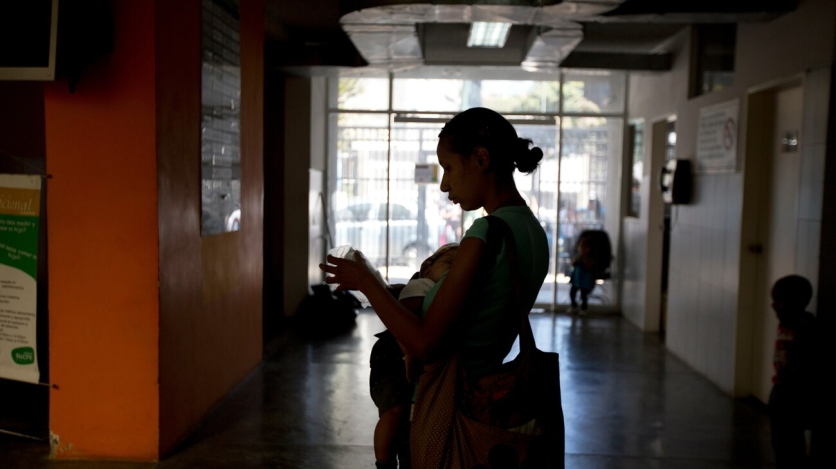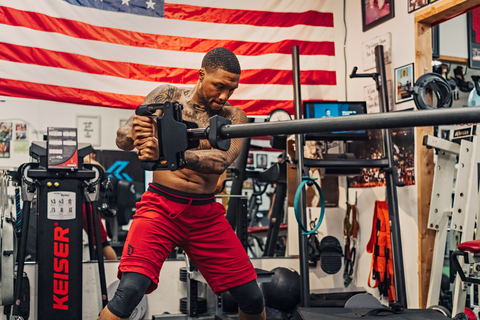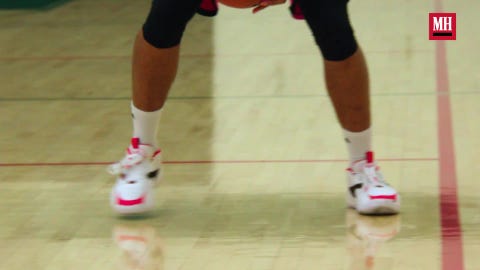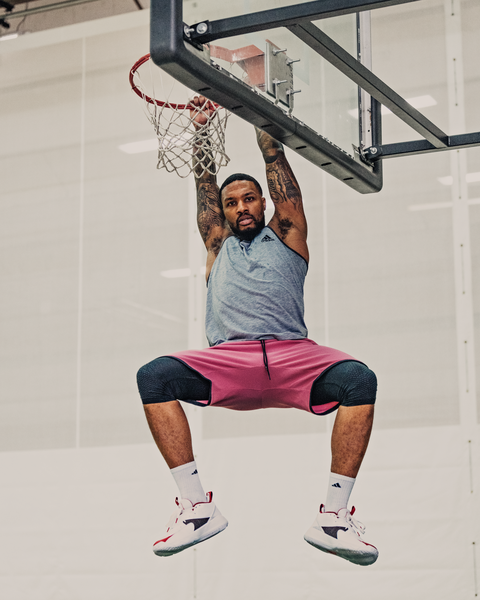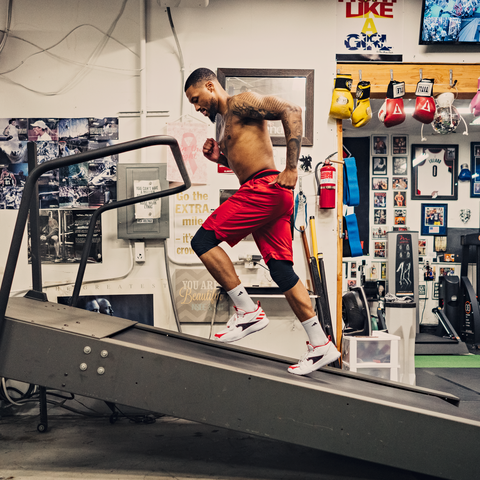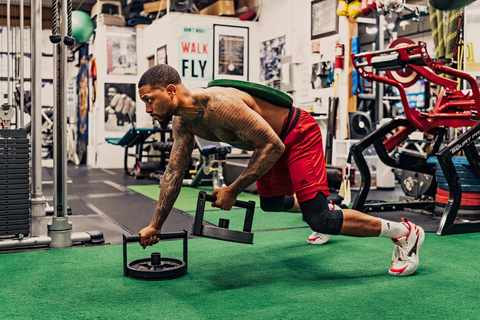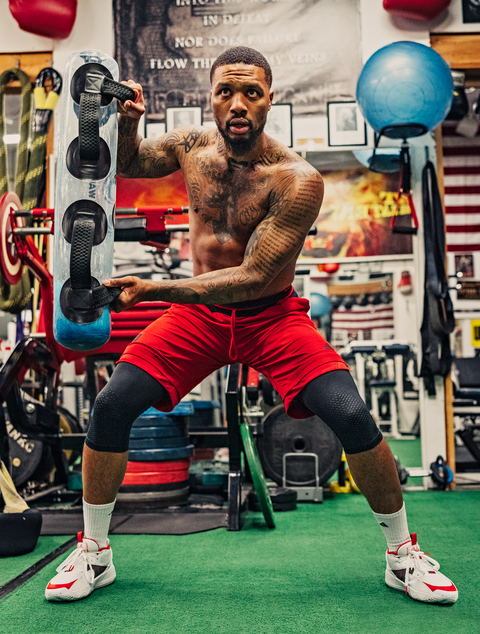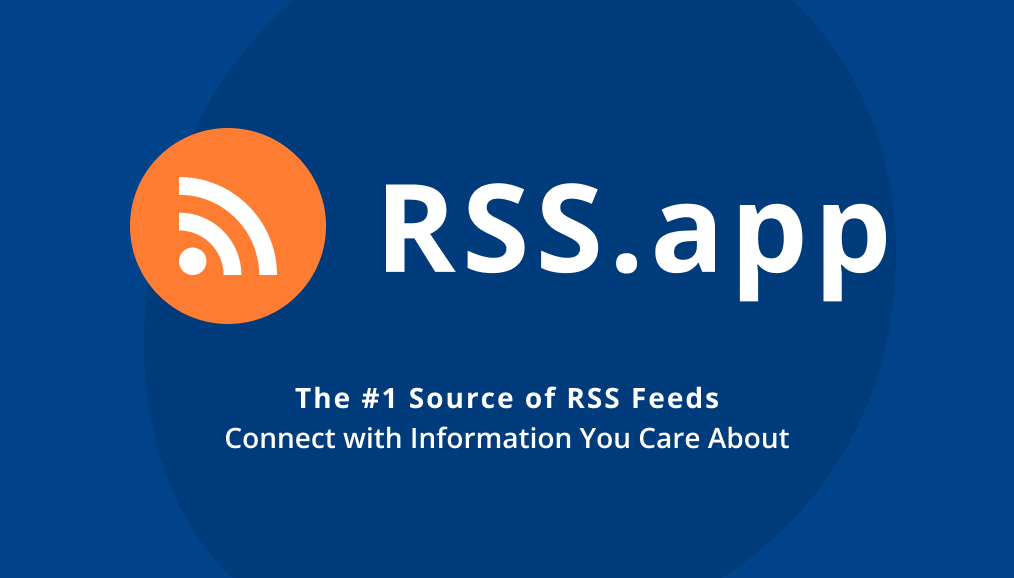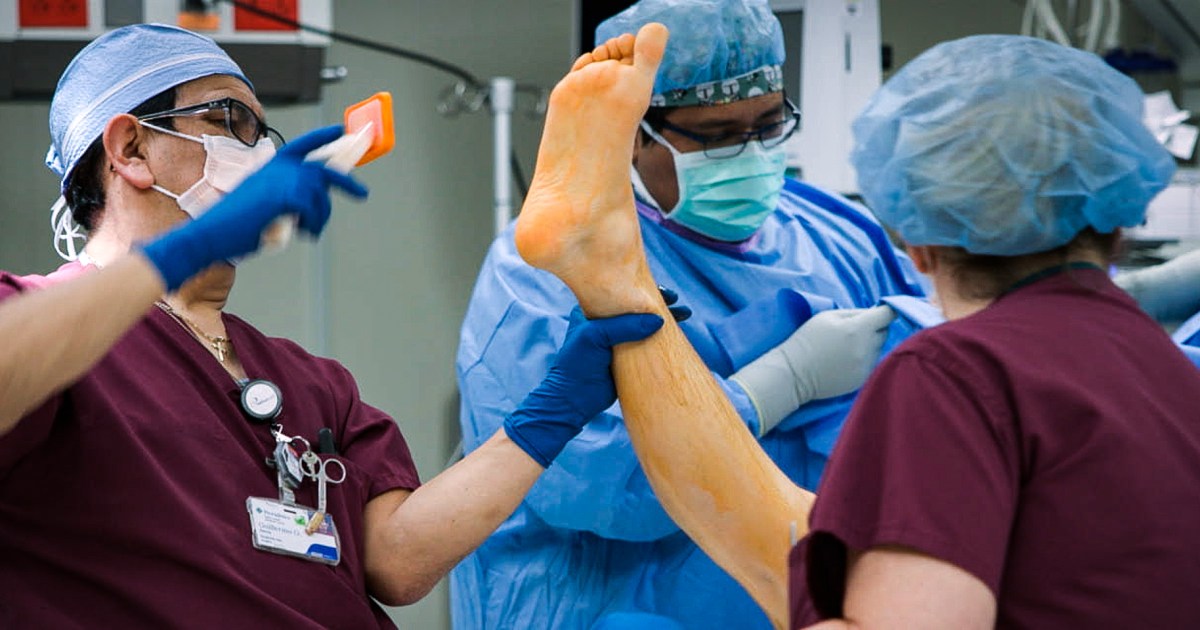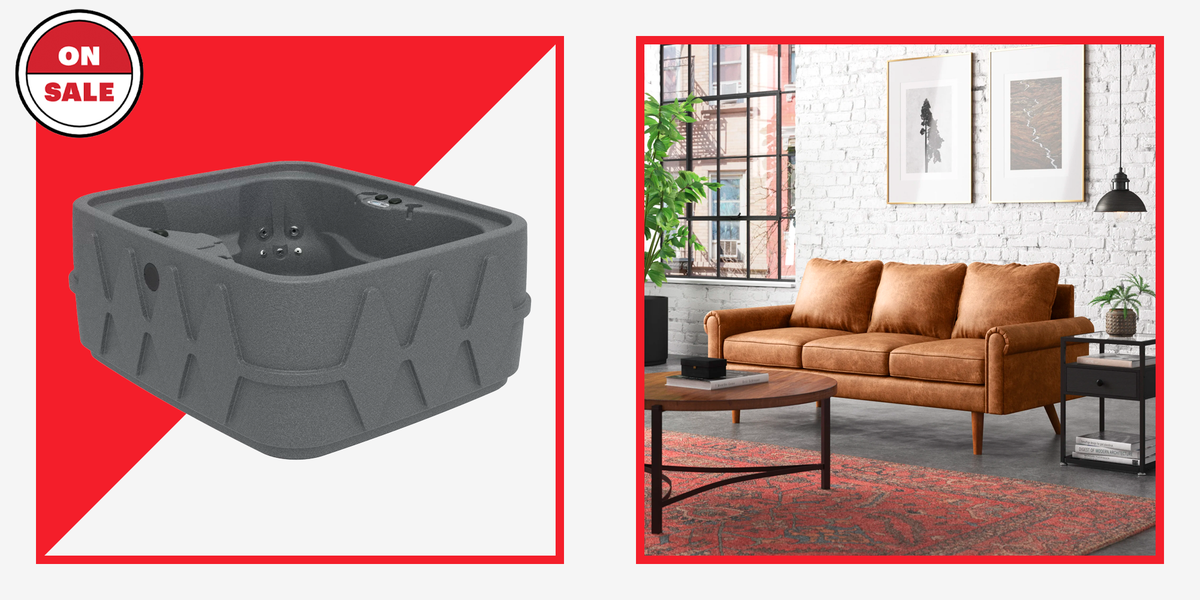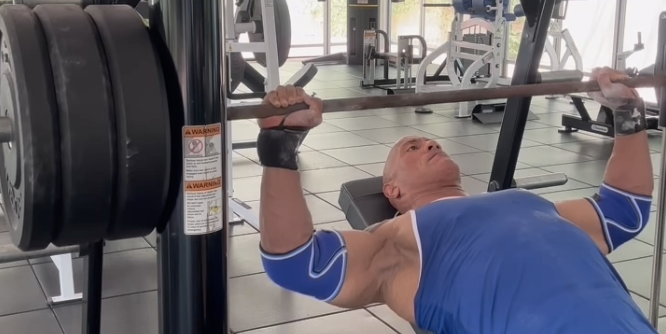DAMIAN LILLARD KNOWS this drill well—but it’s never felt this good. He grabs the thick black handle of the giant machine, called a Proteus Motion, in front of him. The handle is attached to a black tube, which slides in and out of the massive, rotating machine opposite Lillard. An LCD screen sits to the left, tracking his movements.
Lillard is in Gem Fitness (aka the Lions Den), a gym that sits on the outskirts of Portland, Oregon. It’s a multiroom facility that blends classic equipment (dumbbells, sleds, and a single trap bar tucked between a wall and a treadmill) with more unusual gear, like the Proteus, a handful of pneumatic resistance machines, and a mini barbell with grips that slide across it (for better biceps curls). On one wall in the main room, there’s a picture of Lillard, standing, ripped and shirtless and 15 pounds heavier. It was taken during the pandemic, when he showed up here daily and was in the best shape of his life. Back then, he says, “I was just training to train.”
Now he has new purpose: Back in January, the 32-year-old Portland Trail Blazers star shut things down after months (correction: years) struggling with a core muscle injury, and he could only watch (actually, he barely watched; more on that later) as his teammates stumbled to their worst record in 17 years. It was one of the lowest points in Lillard’s storied ten-year NBA career—but he’s turned it into an opportunity. Since then, he’s happily embraced a challenge that almost every guy is destined to face: a comeback.
This moment is part of that. The six-foot-two guard plants his feet, exhales loudly, and starts twisting his torso and hips to the right, pulling the handle back as he does. Then he shifts explosively to the left, abs tensing, grip tightening. Each twist lights up Lillard’s obliques, abs, and hip stabilizers—and a few months ago, each twist would have made him grimace. Not today. Thirty seconds later, he releases the handle and smiles. He gives a silent nod to his longtime trainer, Cem Eren, then walks up to an oversized treadmill set to an incline. “Just being able to get through my workouts strong and comfortable,” he says, “it’s been a blast.”
Coming back from injury is a skill, and like any skill, anyone can master it. This NBA season, that skill will be on display. From New Orleans big man Zion Williamson (foot surgery) to Clippers forward Kawhi Leonard (torn ACL) to Nuggets guard Jamal Murray (torn ACL) to a host of other big names, this season is full of major injury comebacks. And every bounce-back includes lessons that go beyond the physical, because recovering from injury is as much about rebuilding your mind as it is about regenerating muscle tissue.
Lillard knows. He enters this season physically refreshed, and that’s on display during his photo shoot with MH. When somebody tentatively asks him to dunk, instead of worrying about his abs and groin, he coolly bends his knees, then effortlessly explodes upward like a coiled spring. He glances around afterward, as if to make sure everyone saw. Then he dunks again.
His remade body is matched by a new mental approach. Before his injury, like most athletes, he thought himself immortal. Now he’s acutely aware that his body might fail him—and that even his legacy isn’t permanent. His eyes narrow as he quietly focuses on another set on the Proteus. “Subconsciously, I did think I was bulletproof,” he says of his pre-injury mindset. “Now I’m trying to bulletproof myself.”
BEFORE ALL THAT, Damian Lillard had to admit he had a problem. This was a process. He first felt the searing pain along the inside of his right thigh in 2014. The Blazers were in training camp, and Lillard remembers his right lower abdominal area “started locking up” late in a practice session. “I couldn’t bend. I couldn’t run. It was just really uncomfortable,” he says. A day later, he felt the same thing in practice. Weeks later, the pain seemed to go away. Halfway through the regular season, it returned.
The pain was almost always there after that, even when Lillard was at his best. Early in the 2019 season, he recalls dropping a career-high 60 points on the Brooklyn Nets, drawing raves from fans and friends. “And I remember limping into the house,” he says. “I was literally bending over.”
Lillard was dealing with athletic pubalgia, a condition often mislabeled a “sports hernia.” Essentially, his inner thigh muscles had torn slightly, and that was disrupting his movement at the hip. And partly because he’d played through the injury, it was slowly wrecking his abdominal muscles. “It’s like a groin injury that moves up into the abdominal wall,” says Erik Meira, P.T., D.P.T., who would eventually oversee Lillard’s recovery. “It’s not a sensation that you can mentally block out and just go past.”
Except Lillard did exactly that for seven years. But with each season, the pain increased. Last year, he couldn’t ignore it. “I started feeling like my body couldn’t do what my mind wanted it to do,” he says.
So after 29 games, Lillard ended his season and spent early January visiting specialists. By the end of the month, he’d undergone surgery. His rehab kicked into high gear a week later, when he first began working with Meira in Portland—and he had little time to waste. He was expected to be in game shape six weeks after surgery. Yes, that was an aggressive timeline, says Meira, especially when you consider how long the injury had plagued Lillard. But there was a reason: Your muscles are built to be pushed. “If you rehab them slow,” says Meira, “they heal to what’s asked of them.”
No, this doesn’t mean you should ditch your crutches one day after any surgery. But you should go as hard as your PT team says you can in your own rehab. Physical therapist and MH advisor Dan Giordano, D.P.T., C.S.C.S., says to use a pain scale: Don’t be afraid to work up to 3 out of 10 on that scale. “You might have some pain,” he says. “You just shouldn’t push to a higher state of pain.” Lillard handled his own rehab like that. Early on, he says, he felt “uncomfortable as shit,” especially when he moved laterally, as he might do while defending an opponent on the court. He paid no attention, because experts had told him the pain did not indicate reinjury. “I would say the trust I had in them made me more confident to just kind of go,” he says. “I was never hesitant.”
At the end of six weeks, Lillard stepped onto the court with Meira for a one-on-one rebounding drill, which simulated much of the pounding Lillard would take in a game. Meira’s job was to hack Lillard, doing everything to keep him from grabbing a rebound. Lillard dominated. His aggressive rehab approach had worked.
Sort of. Lillard still needed to address his mental health, which is an underrated key to returning from any injury. From afar, he’d seen the Blazers fall apart, and even a string of 60-spots from Dame D.O.L.L.A. wouldn’t have changed that. For the first ten years of his career, he’d battled to dominate every game, even when Portland was being crushed. Months removed from surgery, that seemed silly. “They’re not gonna be worried about my life,” he says, referring to fans, the media, and team brass. “But my kids and my mom and my wife, they’re gonna be in my life forever.”
For the first time since arriving in Portland, he focused on family. He’d pick up his son from school one day, go to Target with his wife, Kay’La, another. There were more FaceTime chats with Mom. Once obsessed with what the media might be saying about him on Twitter, he deleted the app from his phone entirely. “I couldn’t place my happiness in basketball,” he says. “Now I’m seeing this is what really counts.”
Lillard has maintained these new priorities, and that’s allowed him to have more fun with the 82-game NBA grind. And he hasn’t reinstalled Twitter. “I’ll be able to play the game with more joy,” he says, “without caring or expecting anything from [anyone]. I’ll be able to play freely.”
He won’t forget the injury that led to all this, though, because he understands one truth of every comeback: It’s never over. As Lillard rebuilt his core, he discovered other issues. Chief among them—his right Achilles kept tightening up, the result of a broken foot he’d suffered at Weber State University. So even after officially being cleared for game action, he kept training with Meira. The therapist addressed Lillard’s Achilles with eccentric focused calf raises. Lillard would stand with a heavy bar on his shoulders, the balls of his feet on a small block or plate. He’d drive up onto his tiptoes by squeezing both calves. Then he’d remove his left foot from the block and slowly lower back down.
Lillard gradually began refining his in-game imbalances, too. He’d scrimmage with Blazers staff members and have the clips sent to his iPhone to study. He pulls one up after finishing his session with Eren. “See how tentative I am there? That’s not good.” His core stayed on his to-do list, too, because, as Meira says, you never forget an old injury: “You never, ever stamp an injury as ‘healed.’ Ten years down the line, all of a sudden that old injury starts to get achy.”
Not that Meira had to monitor everything alone. Shortly after Lillard completed his rehab work with Meira, he did a Zoom call to introduce Meira to Phil Beckner, his longtime on-court skills trainer, and Eren. He tasked the group with building a schedule that would let him sharpen his game while continuing to build a more durable body. “I just don’t know how to not go hard,” he says. “So I had to make myself not the person in charge. Now they all have the schedule.”
Most days during the summer, he trained with Meira first thing. Then he’d head to Beckner to shoot around. He’d wrap up each day working with Eren. On this day (and most days), Lillard starts with moves to test his abs (see “Core Curriculum,” below), then finishes with boxing drills that hone footwork and build cardio.
And on this day, his old injury is the furthest thing from his mind. His new body has been (and continues to be) tested on the court in scrimmages against Blazers staff members. He’s adhered to every piece of his comeback schedule. “I’m ready,” he says. “And it’s one of the best feelings ever.” After seven years, nothing beats moving pain-free.
Ebenezer Samuel, C.S.C.S., is the fitness director of Men’s Health and a certified trainer with more than 10 years of training experience. He’s logged training time with NFL athletes and track athletes and his current training regimen includes weight training, HIIT conditioning, and yoga. Before joining Men’s Health in 2017, he served as a sports columnist and tech columnist for the New York Daily News.
